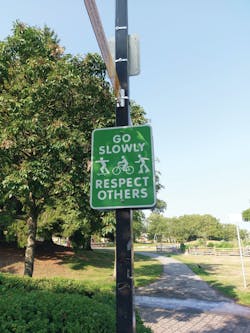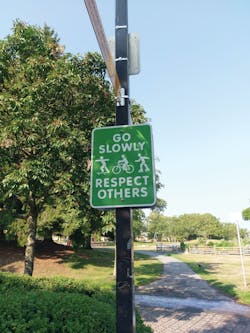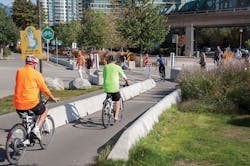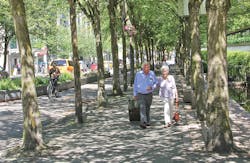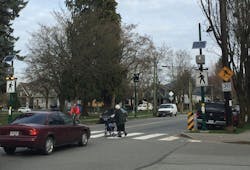Taking action
In the last 20 years in Vancouver, the number of transportation-related fatalities decreased by 40%, despite significant increases in population over this same period (20%). Additionally, between 2011 and 2015, the city of Vancouver had an overall transportation fatality rate of 2.4 fatalities per 100,000 residents, which is very low compared to other peer cities in North America and Europe. Although this is encouraging, there is still room for improvement, as fatalities continue to occur in the transportation system, and even one fatality is too many.
In recent years, the city of Vancouver has taken steps to improve transportation safety by setting a zero transportation-related fatalities target. This target is embedded in the city’s long-term strategy—its “Transportation 2040 Plan”—and was approved by the city council in 2012. In Vancouver, pedestrians and cyclists are involved in only 2% of collisions, but they represent 64% of the fatalities. Moreover, seniors (age 65+) represent 40% of transportation-related fatalities, but account only for 14% of the population. Therefore, elimination of transportation-related fatalities will place special emphasis on vulnerable road users (walkers, cyclists) as well as at-risk groups such as seniors, children and those with mobility challenges.
In 2012, the city completed its first-ever pedestrian safety study. The study involved an in-depth analysis of all reported collisions involving pedestrians over the past six years. The analysis examined where collisions were occurring, when they took place, who was involved in the collisions, and how the collision occurred. Based on the collision analysis, the study identified key areas of focus to enhance pedestrian safety and developed an action plan with engineering, education, and enforcement countermeasures recommended to address each issue. From the engineering perspective, 69 treatments were suggested at priority locations, including pedestrian countdown timers, slower walking speeds at signals, LED lighting, pedestrian signals, left-turn phases, a 30-km/hour arterial speed zone and a leading pedestrian interval (LPI). Between 2012 and 2017, 69 out of the 69 treatments (100%) were completed.
A similar comprehensive study was commissioned in 2015 to review the safety of cycling in Vancouver, and to create an action plan to address identified issues. The action plan included a set of recommended engineering practices such as using protected bike lanes on busy commercial streets, exploring more protected intersections, designing for slow cycling on recreational paths, providing on-street bike facilities where cycling is prevalent and separating pedestrians from cyclists on shared paths, among others. Additionally, corridor and intersection projects were suggested at priority hot spots. To date, Vancouver’s second protected intersection opened to the public in October 2017. Also, various intersection and corridor projects are underway at the consultation, design, or construction stages.
Progress has been made, but further work needs to be done as approximately 45,000 traffic collisions occur in Vancouver every year, resulting in on average 15 fatalities, 300 serious injuries and 10,000 minor injuries.
In early 2016, the city council directed staff to develop a strategy for achieving zero transportation-related fatalities and serious injuries, including a review of best practices from other jurisdictions, an action plan and a funding strategy to accelerate implementation. In late 2016, the council approved the Moving Towards Zero safety strategy with five areas of emphasis.
Enhanced safety data
The traditional Vision Zero concept from Sweden, adopted as a nationwide safety strategy in 1997, includes both zero transportation-related fatalities and zero serious injuries targets. Over the past 30 years, Vancouver has relied mostly on motor vehicle insurance claims collision data, provided annually to the city by the Insurance Corp. of British Columbia (ICBC).
Although the ICBC data set is very comprehensive, information regarding the severity of injuries as a result of a collision or the demographics of road users involved in collisions are not provided. Moreover, information about collisions not involving a motor vehicle (e.g., pedestrian-cyclist collisions, cyclist-cyclist collisions, single cyclist falls, single pedestrian falls) are not reported as they do not involve an insurance claim.
Without a reliable data source of transportation-related serious injuries, it is not possible to track and monitor the city’s zero serious injuries target. To overcome this challenge, Vancouver engaged with health partners and established data-sharing agreements with Vancouver Coastal Health (VCH) and BC Emergency Health Services (BCEHS). The data shared included patient arrivals to Vancouver’s three main hospital emergency departments due to transportation-related injuries.
The analysis of injury data allowed the city to quantify serious injury occurrence, identify hot-spot locations and determine specific affected demographic groups. Furthermore, the data also became a source of non-motorized collision data.
The review of injury data from Vancouver’s three main hospitals showed that transportation-related incidents are the second highest cause of visits to the hospital emergency department, accounting for approximately 20% of all serious injuries. Furthermore, pedestrians and cyclists are the most affected, representing 60% of serious injuries. Additionally, seniors are at high risk of a serious injury if involved in a collision, with 22% of serious injuries involving a senior.
Further review of the hospital data also found that approximately 40% of cycling-related serious injuries did not involve a motor vehicle, and that approximately half of those were single cyclist falls.
Safety action plans created in Vancouver included recommended engineering practices such as using protected bike lanes and pedestrian countdown timers.
Evaluate and prioritize locations
Priority intersections and corridors for further in-depth safety studies were selected by developing collision prediction models. Collision prediction models helped identify locations with the highest risk of fatalities and serious injuries. From this, priority corridors and intersections were identified for pedestrian, cycling, and motor-vehicle collisions.
Priority senior focus areas for deep dive also were identified. From the hospital injury data review, around 45% of fatal and serious injuries involving a senior occurred within 250 meters of a senior home. Locations prioritized included high senior fatality and serious injury locations, as well as high senior population density areas and high senior activity areas such as senior homes and senior centers, among others.
While children were not flagged as an overrepresented group in transportation-related fatalities or serious injuries, it is recognized that they are one of the most vulnerable road users and will be proactively prioritized through the city’s School Active Travel Planning Program (SATPP). As part of the SATPP, city staff work directly with schools on improving active travel and safety for walking and cycling. The program includes an assessment of the selected schools by examining their unique transportation profiles and challenges, and the development of an action plan to work with the school community and relevant stakeholders to address the identified issues. Each year four to six schools are selected to participate. The program will have a strong emphasis on safety using a data-driven approach to select participating schools and identify safety upgrades. Staff also will take the opportunity to leverage new safety improvements at schools where construction or development is occurring and implement low-cost safety measures to more schools.
Seniors and children are at high-risk of serious injury in pedestrian-involved collisions with a vehicle.
Implement engineering initiatives
Given the limited resources available for safety improvements, it is critical to take a databased approach in implementing road safety measures. As a result, the city undertook an assessment of the effectiveness of each measure including actions recommended in the 2012 pedestrian safety study and 2015 cycling safety study. The tool-kit validation helped identify the most successful measures in reducing fatalities and injury collisions in a Vancouver context for further application at priority locations.
Additionally, new measures which have shown successful results in other cities are currently being tested in Vancouver. For example, Rectangular Rapid Flashing Beacons (RRFB) were implemented in three pilot intersections in 2016. These are pedestrian-activated, high-intensity amber beacons used to alert drivers to yield to pedestrians at marked crosswalks. On average, observed driver yielding compliance to pedestrians increased from 50% before the RRFB, to 97% one year after installation. The city also has implemented LPIs, which give pedestrians a head start at signalized intersections. This measure has been implemented in many cities, and Vancouver is closely reviewing the implementation to determine its effectiveness from a city context before expanding its use.
It also should be noted that Vancouver approved its first congestion management strategy in 2017 with a focus on a predictable and reliable network. Historically, congestion management has been seen as having an adverse effect on road safety. However, Vancouver will be looking at innovative ways to approach both road safety and congestion management together.
Finally, a countermeasure-based strategy was used to develop a quick-start action plan that can be implemented in the short term. The strategy identifies collision types that can be targeted by specific countermeasures, and then searches for locations that have overrepresentation of those collision types. For example, a countermeasure such as improving lighting by adding LED fixtures at intersections would focus on locations with collisions occurring after dark.
Prioritize enforcement
Vancouver has a long history of working with senior levels of government and the Vancouver Police Department (VPD) to strategically develop initiatives to promote awareness to road safety in the city. It is recognized that engineering countermeasures alone cannot eliminate all fatalities or serious injuries, but partnered with education and enforcement, the culture and perspective of safety on the roads can be changed.
The city of Vancouver will continue to work in cooperation with the VPD to develop targeted enforcement programs to tackle dangerous behavior at priority locations. Specifically, this includes meeting routinely to review ongoing road safety concerns, new road designs and targeted enforcement campaigns. This has helped to build strong working relationships and break down cross-departmental barriers. In addition, limited enforcement resources can be targeted more strategically. Targeted behaviors include both those related to driving such as speeding, distracted driving, impaired driving, and failure to yield to pedestrians, as well as unsafe pedestrian and cycling behaviors at high-incident areas.
The goal of the “Mindful Travel” safety campaign is to influence travel behavior by focusing on the local character of Vancouver as a multimodal city.
Education and public outreach
Steps to engage Vancouverites to travel safely have been taken by developing the “Mindful Travel: Getting Around the Vancouver Way” safety campaign. The goal is to influence travel behavior and focus on positive messages, humor, and the local character of Vancouver as a multimodal city instead. The campaign places emphasis on educating Vancouverites to share the road and promotes safe, courteous, and mindful road-user behaviors. Campaign materials have been rolled out on a small scale through print materials at events, as well as via the city of Vancouver’s web page and social media accounts during 2017.
Additionally, in 2017 a disability awareness course was organized for city staff with the goal of improving awareness of challenges experienced by persons with physical or visual disabilities so their needs can be better accommodated in the planning, design and construction of the city’s streets. The training allowed staff to experience physical or visual disabilities by using wheelchairs, vision impairment goggles and white canes while navigating the city’s streets.
Next steps
The next steps of the plan include an ongoing monthly review of hospital injury data to continue tracking progress; completing intersection and corridor in-depth safety studies and developing an action plan to address identified safety issues; working on the school program and implementing a quick-start safety action plan; and continuing to work in collaboration with safety partners and expanding the mindful travel campaign to a multi-year initiative.
Vancouver’s safety program is further outlined at http://vancouver.ca/streets-transportation/transportation-safety.aspx.
